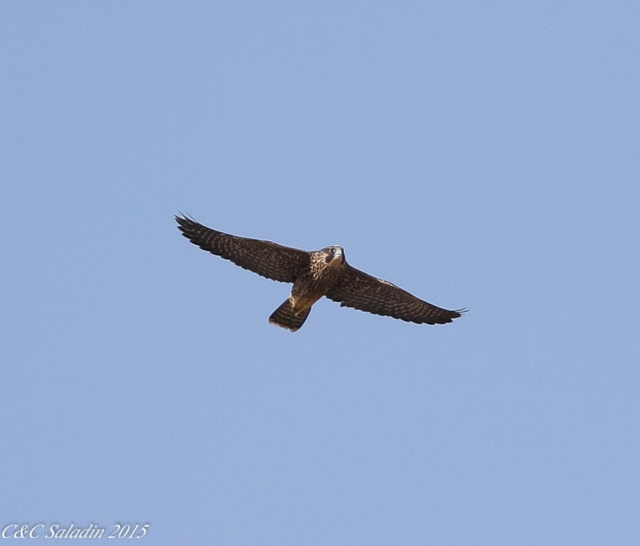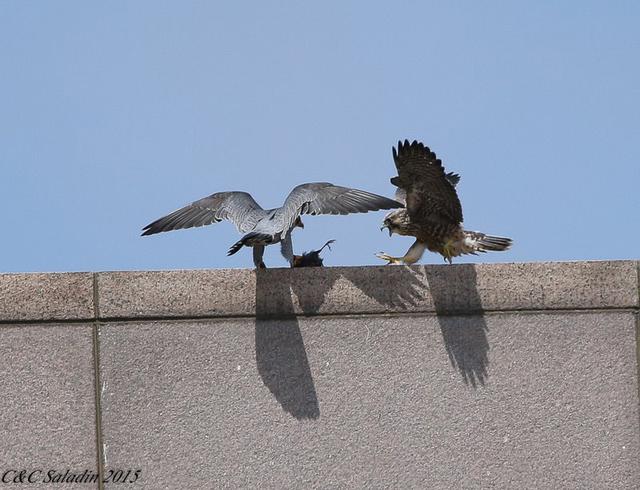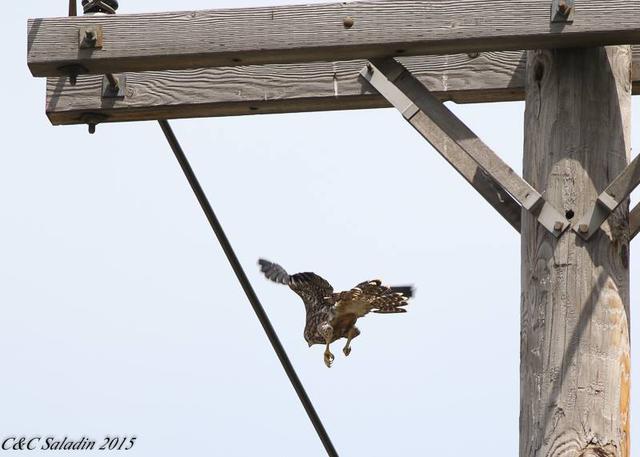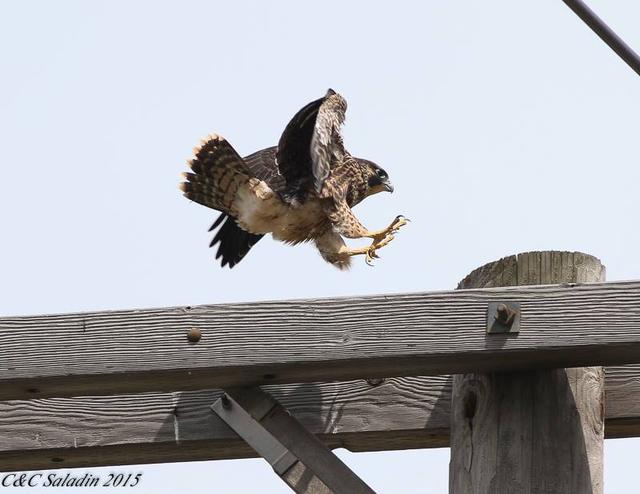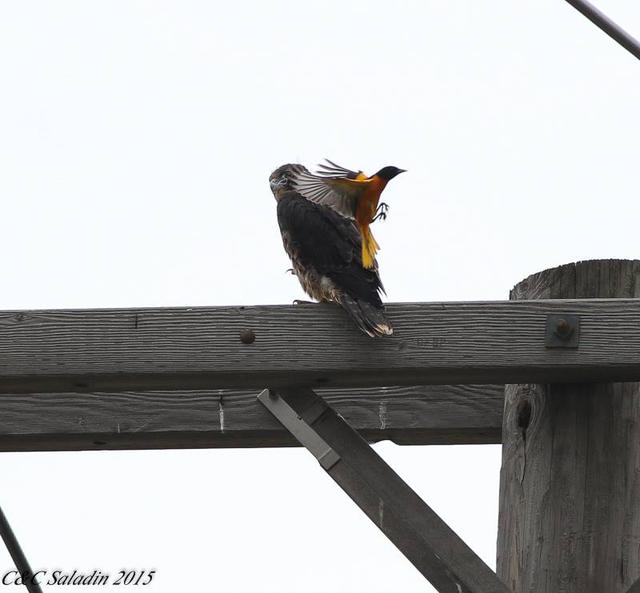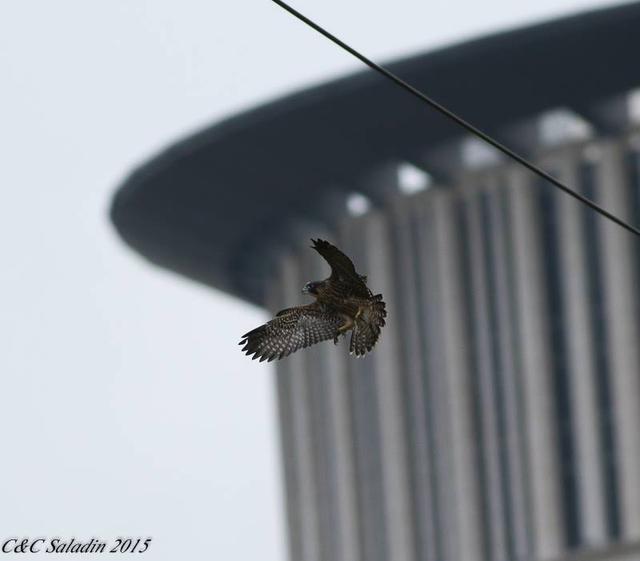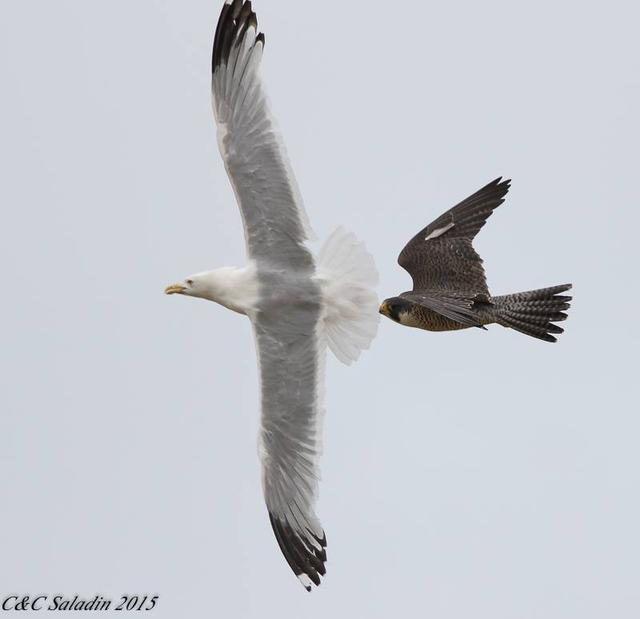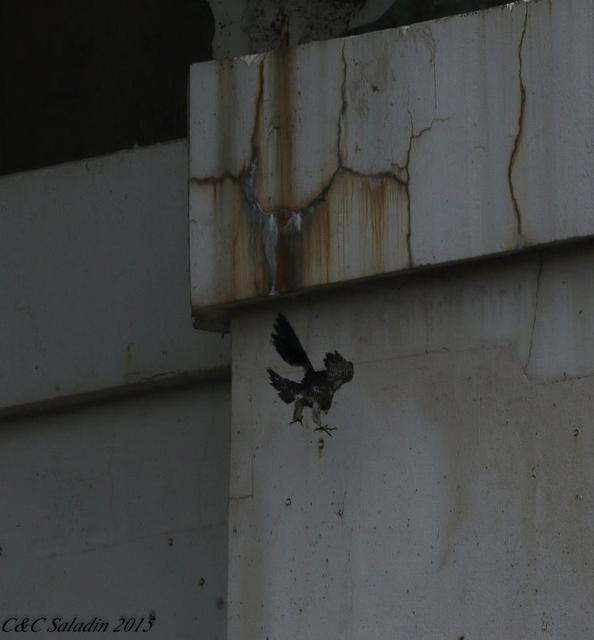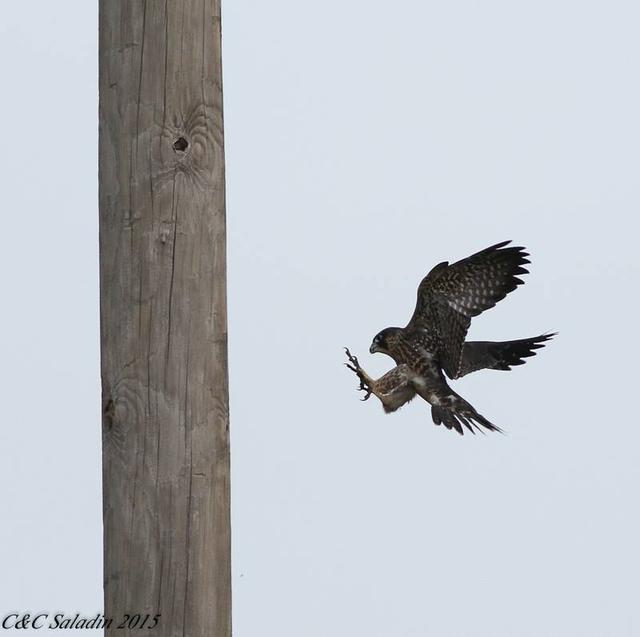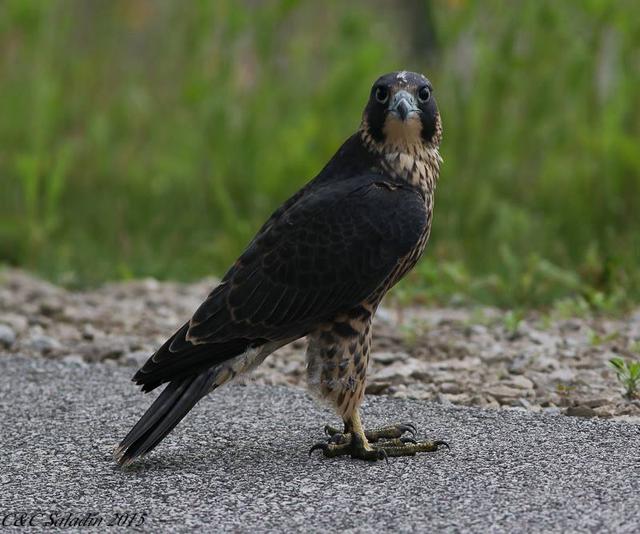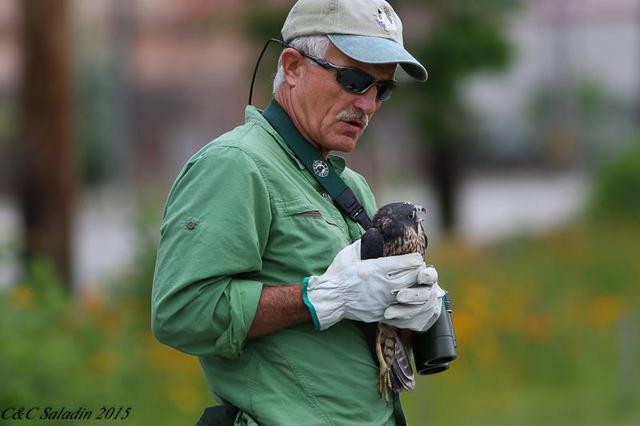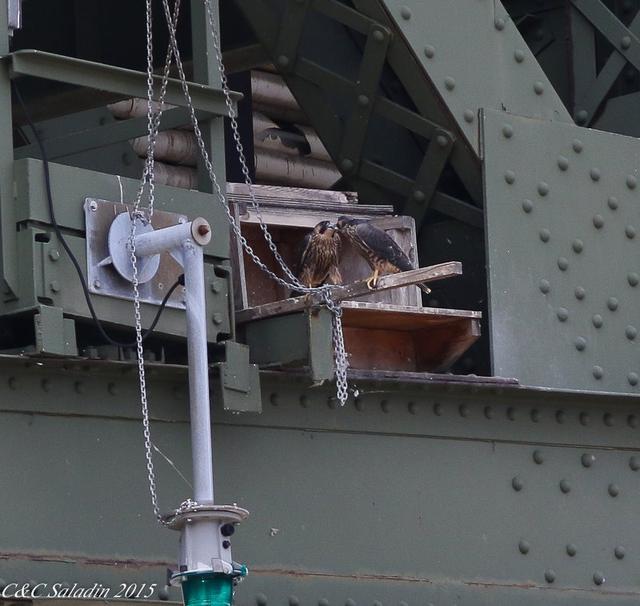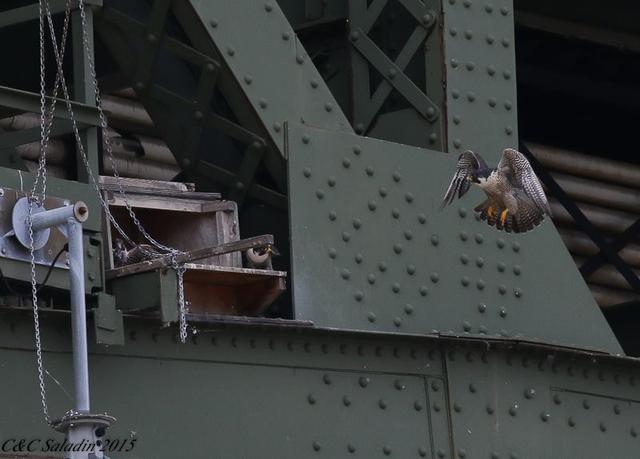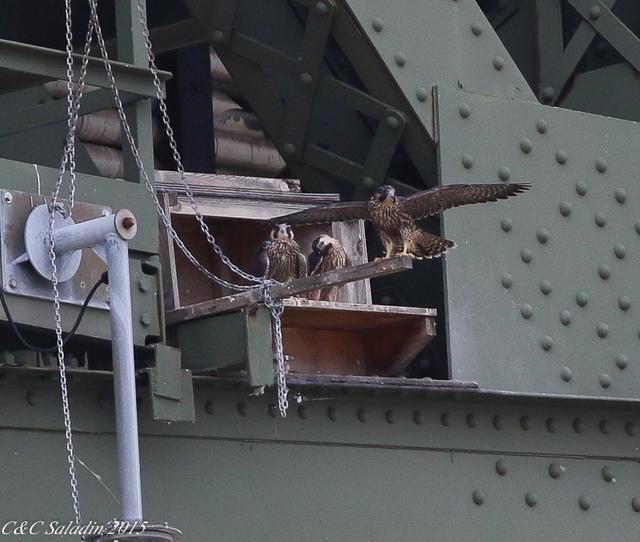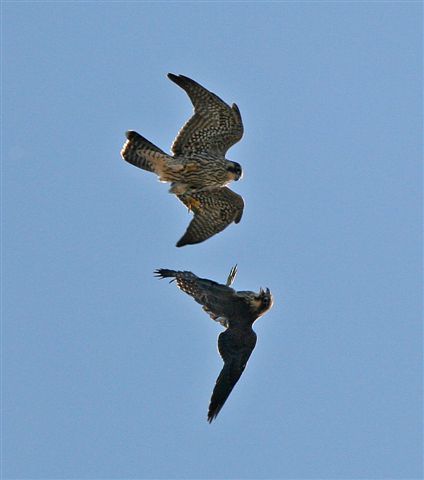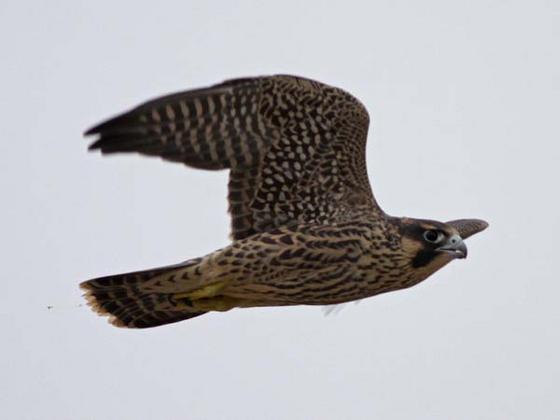FALCON FLASH
Dateline: Cleveland, Ohio
June 23, 2015
Click here to read what happened earlier
However, the juvenile, who Mr. and Mrs. Saladin have named “Watson”, missed his first attempt to land…..
It’s been a week for fledging in Cleveland and many juveniles are now flying successfully - and some are already soaring high in the sky
And here he is landing after a good flight…………..
Until a seagull started chasing the juvenile. His mom, Cuyahoga, was nearby watching and chased the gull away….
And ended up on the ground as cars went whizzing by.
At the Cleveland Clinic, Dipper and Ely’s youngsters have all taken their first flights successfully. They will stay close to the nestsite for the next month or two, and Dipper and Ely will watch over them, feed them, and help them learn hunting and flying skills.
We all know about Phelps the now famous swimming chick. At Phelps’ nestsite on the Hope Memorial Bridge, his 3 other siblings have had some successes and a failure. A few days after Phelps’s river swims and rescues, one of his siblings took his first successful flight, although it was a bit scary. Here he is taking off……
But there was a problem. He had entered the territory of a Baltimore Oriole and some Grackles, and they dive-bombed him……
Nevertheless, he stayed on a telephone pole overnight. The next morning he flew to another spot where his mom, Cuyahoga, fed him.
Volunteer nest monitors, Mr. and Mrs. Saladin, watched the next juvenile fledge. It seemed to be going well…..
In just 6 weeks, those tiny newly hatched eyasses have grown to the size of their parents – or even bigger! The following is a picture of Dipper delivering prey to his big kid. At this stage, the juvenile falcons are sometimes aggressive when taking the food away from their parents, and you can see Dipper is respectful of his hungry offspring.
Then tried to land on the side of a telephone pole, which also didn’t work …..
Mr. and Mrs. Saladin report, “After watching Watson walking among the flowers and weeds under the bridge and seeing the limited options that he had for trying to get higher to ladder his way back toward the nest site, we used our shared judgment in deciding to pick him up. This took much consideration, as we believe in letting juvies work themselves out of problems as much as possible, but in this case it appeared that Watson would either try to fly toward the poles along the busy road or would try a take-off from the thicker weeds toward the river, where there would be only a few precarious landing options even if he got some elevation and he would likely be attacked by gulls nesting on the concrete structures near the bridge”. Notice the heavy gloves Mr. Saladin wears – he knows how sharp those talons are.
Watson was taken to the Medina Raptor Center where he joined his brother Phelps. Phelps and Watson’s last sibling flew successfully 2 days ago, so yesterday Phelps was returned to their nestsite. Watson will be returned soon. Mr. and Mrs. Saladin report, “As much as the first attempt to return Phelps to the nest site didn't work out, today his return was much more of what you hope for! …. We returned Phelps to the bridge today via a "soft release", taking off the carrier door and placing the carrier on the catwalk that runs alongside the nest box. This time, the adults were not in view while we were inside the bridge (as the other two juvies were away from the nest box area), so there were no alarm vocalizations and Phelps walked out of the carrier not long after we placed it onto the catwalk”.
This draws the 2015 Raptors in the City program to a close. Be sure to join us early next year when the cycle of life begins again. What new dramas will unfold?
Our thanks to the Cleveland Museum of Natural History for sponsoring the FalconCams and for the still. Learn more about the museum at: http://www.cmnh.org/
Our special thanks to volunteer peregrine nest monitors Mr. and Mrs. Saladin for their descriptions and photos. Most of all a big thank you for all their service, care and concern for the species peregrine falcon.
“He proceeded to walk to the front toward the nest box, flapping in the breeze, hopped onto the catwalk railing and then onto the box, and flapped and lifted slightly off the top of the box as he peered out into the familiar open space in front of him…... Soon afterward, Phelps hopped and flapped from the box to the
catwalk railing and eventually down into the box where he greeted his brother”.
Phelps’ parents also welcomed him home. Bolt, his dad, flew in with prey as Cuyahoga, his mom, hovered nearby.
Mr. and Mrs. S tell us, “Phelps didn't fly the remainder of the time while we were there, but he was very active, messing with the chain near the box, beak touching with his brother, and walking, flapping, and taxiing along the bridge arches”. Here he is flapping his wings and getting up the courage to fly. He is
now strong enough and old enough to fly successfully.
The young peregrines will practice take-offs and landings, soaring and gliding, and how to do the fastest maneuver of all, the straight-down dive called the stoop. Their parents will teach them to hunt. As they get more advanced, a parent will drop prey for them to catch in the air. They will also go on "family hunting forays" where the adults and juveniles cooperatively hunt. Mr. and Mrs. Saladin tell us,
“During aerial play, you often get to see their skill development, as the juvies chase and grab for one another in flight, simulating hunts and aerial defense. They also imitate aerial food exchanges with one another, positioning underneath and inverting to touch feet-to-feet in mock exchanges”.
They also play at “mock combat” to practice fighting skills. Peregrines are fierce predators and will fight to protect their territories.
The family will stay together for several months as the youngsters learn to be self-sufficient, but soon they will begin their own lives and fly to parts unknown. Where will they go and how will their lives turn out?

